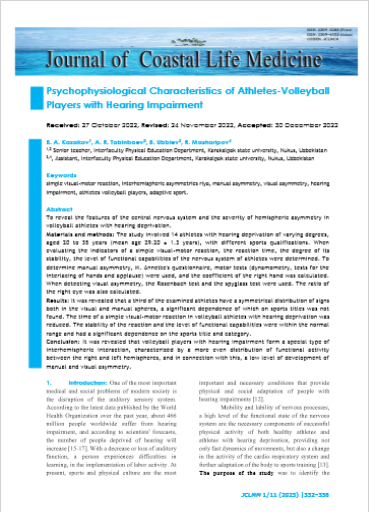Psychophysiological Characteristics of Athletes-Volleyball Players with Hearing Impairment
Main Article Content
Abstract
To reveal the features of the central nervous system and the severity of hemispheric asymmetry in volleyball athletes with hearing deprivation.
Materials and methods: The study involved 14 athletes with hearing deprivation of varying degrees, aged 20 to 35 years (mean age 29.20 ± 1.3 years), with different sports qualifications. When evaluating the indicators of a simple visual-motor reaction, the reaction time, the degree of its stability, the level of functional capabilities of the nervous system of athletes were determined. To determine manual asymmetry, M. Annette's questionnaire, motor tests (dynamometry, tests for the interlacing of hands and applause) were used, and the coefficient of the right hand was calculated. When detecting visual asymmetry, the Rosenbach test and the spyglass test were used. The ratio of the right eye was also calculated.
Results: It was revealed that a third of the examined athletes have a symmetrical distribution of signs both in the visual and manual spheres, a significant dependence of which on sports titles was not found. The time of a simple visual-motor reaction in volleyball athletes with hearing deprivation was reduced. The stability of the reaction and the level of functional capabilities were within the normal range and had a significant dependence on the sports title and category.
Conclusion: It was revealed that volleyball players with hearing impairment form a special type of interhemispheric interaction, characterized by a more even distribution of functional activity between the right and left hemispheres, and in connection with this, a low level of development of manual and visual asymmetry.
Article Details
References
Aizman, R.l. Functional reserves of young men involved in skiing/R.l. Aizman // Vestnik Novosibirsk, state ped. university - 2012. - No. 6. pp. 45-49.
Aleksanyan, О. V. Psychophysiological features of children deprived of hearing / О. V. Aleksanyan // Vestnik Ros. University of Friendship of Peoples. Series: Medicine. - 2010. - pp. 77- 80.
Baiguzhin, P. A. Functional state of the central nervous system under the influence of weakly structured information / P.A. Baiguzhin, D.Z. Shibkova //Man. Sport. Medicine. - 2017. - No. S. - P. 32-42.
Grechishkina S. S. Features of the functional state of the cardiorespirator system and neurophysiological status of track and field athletes / S. S. Buckwheat on // Bulletin of the Tomsk State University, ped. university - 2011. - No. 5. -P. 49-53.
Dobrokhotova, T.A. Functional human asymmetries /Т.A. Dobrokhotov. - М.: Medicine, 1981. - 288 p. 7. Kolomiets, O.l. Quantum influence in optimizing the psychophysical state of athletes (on the example of martial arts) / O.l. Kolomiets // Uchenye zapiski un-ta im. P.F. Lesgaft. - 2011. - No. 6. - P. 86-90.
Maryasovva, D.A. Psychophysiological features of highly qualified disabled athletes with lesions of the musculoskeletal system / D.A. Maryasova, E. V. Linde // Science and sport: current trends. - 2015. - No. 1. - P. 51-55.
Polyakov, V.M. Features of the formation of functional interhemispheric asymmetry in children and adolescents with essential arterial hypertension / V.M. Polyakov// Vestnik Ros. academy of medical Sciences. - 2014. - No.9-10. - P. 77-81.
Khalfina, R.R. Peculiarities of sensorimotor reaction of sportsmen of service applied sport/R.R. Khalfina //Bulletin of Kemerovo, state university - 2015. - No.2. - P. 113-116.
Deafness and hearing loss // World Health Organization. - https://www.who.int/news-room/ fact-sheets/detail/ deafness-and hearing- loss (accessed 08/15/2019).
Lin, FR Hearing loss prevalence and risk factors among older adults in the United States / FR Lin // Gerontol A. - 2011. - No. 66. - P. 582-590.
Wang, J. Cross-sectional epidemiology of hearing loss in Australian children aged 11-12 years old and 25-year secular trends /J. Wang // Arch Dis Child. - 2018. - No. 103. - P. 579-585.
Wang, J. How body composition influences hearing status by mid-childhood and mid-life: The Longitudinal Study of Australian Children / J. Wang // International Journal of Obesity - 2018. - No. 42. - P. 1771- 1781.

